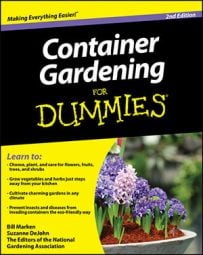Although plants in containers can survive without plant food or fertilizer, making sure you plant have required nutrients will keep them healthy and attractive. Through photosynthesis, plants manufacture their own food.
In fact, all life on earth relies on photosynthesis — the process by which plants (using the energy of the sun) convert water and air into sugars. These sugars are the “food” they burn for energy to live and grow. In the process, they consume carbon dioxide and release oxygen. So when you say you’re feeding your plants, that’s not exactly what you’re doing; rather, you’re fertilizing them — supplying them with certain nutrients they need to thrive. Think of fertilizer as akin to the vitamins you take.
Plants absorb most of their nutrients from the soil — specifically, the soil solution, which is the moisture contained in the spaces between soil particles. If any nutrients are lacking or are present only in forms that plants can’t absorb, plants won’t grow to their full potential. Plants growing in the ground have far-ranging roots that seek out what the plants need. Plants whose roots are confined to containers rely on you to provide a consistent supply of nutrients.
For healthy growth, plants need 16 different elements. Carbon, hydrogen, and oxygen — the foundation blocks for photosynthesis — are required in large quantities. Plants get these from air and water. Plants also need relatively large amounts of nitrogen, phosphorus, and potassium. These elements are called primary nutrients, and they form the basis for most fertilizers.
The following table gives you a rundown of the roles that plant nutrients play, as well as signs that a plant is lacking a particular nutrient.
| Nutrient (and Abbreviation) | Role | Symptoms of Deficiency | Notes |
|---|---|---|---|
| Nitrogen (N) | Key part of plant proteins and chlorophyll; the green pigment that plays a vital role in photosynthesis | Yellowing of older leaves first; general slowdown in growth | Mobile in soil — easily washed away during watering |
| Phosphorus (P) | Healthy root growth, plus flower, fruit, and seed production | Stunted plants with dark green or purplish foliage and stems | Immobile in soil; may be present but unavailable to plants due to improper pH or cool soil |
| Potassium (K) (also known as potash) | Vigorous growth, disease resistance, and fruiting | Yellowing along leaf edges and between veins; poorly developed fruit | Avoid over-fertilizing with potassium, as it can make other nutrients unavailable to plants |
Secondary nutrients — calcium, magnesium, and sulfur — are required in smaller quantities. While they’re usually present in sufficient quantities in garden soil, they may be lacking in soil-less mixes, especially those that contain few ingredients.
The micronutrients — you guessed it — are needed in even smaller amounts. They include iron, manganese, copper, boron, molybdenum, chlorine, and zinc, and perhaps others — researchers are still studying the nuances of plant nutrition. Like secondary nutrients, micronutrients may be lacking in soil-less mixes.

